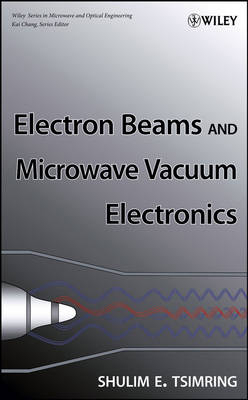
Electron Beams and Microwave Vacuum Electronics
Wiley-Interscience (Verlag)
978-0-470-04816-0 (ISBN)
SHULIM E. TSIMRING, PhD, DSc, is a consultant in the field of applied physics. Dr. Tsimring has taught at a number of universities, most recently as a professor at Nizhny Novgorod State University, Russia. Simultaneously, he was engaged in powerful high-frequency electronics research at the Institute of Applied Physics of the Russian Academy of Sciences in Nizhny Novgorod.
PREFACE. Introduction.
I.1 Outline of the Book.
I.2 List of Symbols.
I.3 Electromagnetic Fields and Potentials.
I.4 Principle of Least Action. Lagrangian. Generalized Momentum. Lagrangian Equations.
I.5 Hamiltonian. Hamiltonian Equations.
I.6 Liouville Theorem.
I.7 Emittance. Brightness.
PART I ELECTRON BEAMS.
1 Motion of Electrons in External Electric and Magnetic Static Fields.
1.1 Introduction.
1.2 Energy of a Charged Particle.
1.3 Potential–Velocity Relation (Static Fields).
1.4 Electrons in a Linear Electric Field e0E ¼ kx.
1.5 Motion of Electrons in Homogeneous Static Fields.
1.6 Motion of Electrons in Weakly Inhomogeneous Static Fields.
1.6.1 Small Variations in Electromagnetic Fields Acting on Moving Charged Particles.
1.7 Motion of Electrons in Fields with Axial and Plane Symmetry. Busch’s Theorem.
2 Electron Lenses.
2.1 Introduction.
2.2 Maupertuis’s Principle. Electron-Optical Refractive Index.
Differential Equations of Trajectories.
2.3 Differential Equations of Trajectories in Axially Symmetric Fields.
2.4 Differential Equations of Paraxial Trajectories in Axially Symmetric Fields Without a Space Charge.
2.5 Formation of Images by Paraxial Trajectories.
2.6 Electrostatic Axially Symmetric Lenses.
2.7 Magnetic Axially Symmetric Lenses.
2.8 Aberrations of Axially Symmetric Lenses.
2.9 Comparison of Electrostatic and Magnetic Lenses. Transfer Matrix of Lenses .
2.10 Quadrupole lenses.
3 Electron Beams with Self Fields.
3.1 Introduction.
3.2 Self-Consistent Equations of Steady-State Space-Charge Electron Beams.
3.3 Euler’s Form of a Motion Equation. Lagrange and Poincare´ Invariants of Laminar Flows.
3.4 Nonvortex Beams. Action Function. Planar Nonrelativistic Diode.
Perveance. Child–Langmuir Formula. r- and T-Modes of Electron Beams.
3.5 Solutions of Self-Consistent Equations for Curvilinear Space-Charge Laminar Beams. Meltzer Flow. Planar Magnetron with an Inclined Magnetic Field. Dryden Flow.
4 Electron Guns.
4.1 Introduction.
4.2 Pierce’s Synthesis Method for Gun Design.
4.3 Internal Problems of Synthesis. Relativistic Planar Diode. Cylindrical and Spherical Diodes.
4.4 External Problems of Synthesis. Cauchy Problem.
4.5 Synthesis of Electrode Systems for Two-Dimensional Curvilinear Beams with Translation Symmetry (Lomax–Kirstein Method). Magnetron Injection Gun.
4.6 Synthesis of Axially Symmetric Electrode Systems.
4.7 Electron Guns with Compressed Beams. Magnetron Injection Gun.
4.8 Explosive Emission Guns.
5 Transport of Space-Charge Beams.
5.1 Introduction.
5.2 Unrippled Axially Symmetric Nonrelativistic Beams in a Uniform Magnetic field.
5.3 Unrippled Relativistic Beams in a Uniform External Magnetic Field..
5.4 Cylindrical Beams in an Infinite Magnetic Field.
5.5 Centrifugal Electrostatic Focusing.
5.6 Paraxial-Ray Equations of Axially Symmetric Laminar Beams.
5.7 Axially Symmetric Paraxial Beams in a Uniform Magnetic Field with Arbitrary Shielding of a Cathode Magnetic Field.
5.8 Transport of Space-Charge Beams in Spatial Periodic Fields.
PART II MICROWAVE VACUUM ELECTRONICS.
6 Quasistationary Microwave Devices.
6.1 Introduction.
6.2 Currents in Electron Gaps. Total Current and the Shockley–Ramo Theorem.
6.3 Admittance of a Planar Electron Gap. Electron Gap as an Oscillator. Monotron.
6.4 Equation of Stationary Oscillations of a Resonance Self-Excited Circuit.
6.5 Effects of a Space-Charge Field. Total Current Method. High-Frequency Diode in the r-Mode. Llewellyn–Peterson Equations.
7 Klystrons.
7.1 Introduction.
7.2 Velocity Modulation of an Electron beam.
7.3 Cinematic (Elementary) Theory of Bunching.
7.4 Interaction of a Bunched Current with a Catcher Field. Output Power of A Two-Cavity Klystron.
7.5 Experimental Characteristics of a Two-Resonator Amplifier and Frequency-Multiplier Klystrons.
7.6 Space-Charge Waves in Velocity-Modulated Beams.
7.7 Multicavity and Multibeam Klystron Amplifiers.
7.8 Relativistic Klystrons.
7.9 Reflex Klystrons.
8 Traveling-Wave Tubes and Backward-Wave Oscillators (O-Type Tubes).
8.1 Introduction.
8.2 Qualitative Mechanism of Bunching and Energy Output in a TWTO.
8.3 Slow-Wave Structures.
8.4 Elements of SWS Theory.
8.5 Linear Theory of a Nonrelativistic TWTO. Dispersion Equation, Gain, Effects of Nonsynchronism, Space Charge, and Loss in a Slow-Wave Structure.
8.6 Nonlinear Effects in a Nonrelativistic TWTO. Enhancement of TWTO Efficiency (Velocity Tapering, Depressed Collectors).
8.7 Basic Characteristics and Applications of Nonrelativistic TWTOs.
8.8 Backward-Wave Oscillators.
8.9 Millimeter Nonrelativistic TWTOs, BWOs, and Orotrons.
8.10 Relativistic TWTOs and BWOs.
9 Crossed-Field Amplifiers and Oscillators (M-Type Tubes).
9.1 Introduction.
9.2 Elementary Theory of a Planar MTWT.
9.3 MTWT Amplification.
9.4 M-type Injected Beam Backward-Wave Oscillators (MWO, M-Carcinotron).
9.5 Magnetrons.
9.6 Relativistic Magnetrons.
9.7 Magnetically Insulated Line Oscillators.
9.8 Crossed-Field Amplifiers.
10 Classical Electron Masers and Free Electron Lasers.
10.1 Introduction.
10.2 Spontaneous Radiation of Classical Electron Oscillators.
10.3 Stimulated Radiation of Excited Classical Electron Oscillators.
10.4 Examples of Electron Cyclotron Masers.
10.5 Resonators of Gyromonotrons (Free and Forced Oscillations).
10.6 Theory of a Gyromonotron.
10.7 Subrelativistic Gyrotrons.
10.8 Elements of Gyrotron Electron Optics.
10.9 Mode Interaction and Mode Selection in Gyrotrons. Output Power Systems.
10.10 Gyroklystrons.
10.11 Gyro-Traveling-Wave Tubes.
10.12 Applications of Gyrotrons.
10.13 Cyclotron Autoresonance Masers.
10.14 Free Electron Lasers.
Appendixes.
1. Proof of the 3/2 Law for Nonrelativistic Diodes in the r-Mode.
2. Synthesis of Guns for M-Type TWTS and BWOS.
3. Magnetic Field in Axially Symmetric Systems.
4. Dispersion Characteristics of Interdigital and Comb Structures.
5. Electromagnetic Field in Planar Uniform Slow-Wave Structures.
6. Equations of Free Oscillations of Gyrotron Resonators.
7. Derivation of Eqs. (10.66) and (10.67).
8. Calculation of Fourier Coefficients in Gyrotron Equations.
9. Magnetic Systems of Gyrotrons.
References.
Index.
| Erscheint lt. Verlag | 31.10.2006 |
|---|---|
| Reihe/Serie | Wiley Series in Microwave and Optical Engineering |
| Sprache | englisch |
| Maße | 165 x 239 mm |
| Gewicht | 955 g |
| Themenwelt | Technik ► Elektrotechnik / Energietechnik |
| ISBN-10 | 0-470-04816-6 / 0470048166 |
| ISBN-13 | 978-0-470-04816-0 / 9780470048160 |
| Zustand | Neuware |
| Haben Sie eine Frage zum Produkt? |
aus dem Bereich


